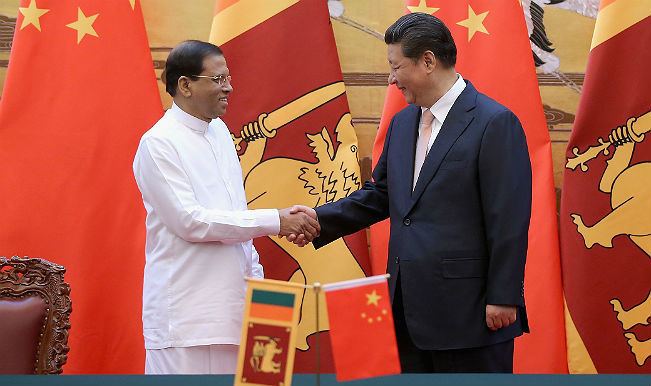 | ||
The China–Sri Lanka relations refers to bilateral relations between the People's Republic of China and Democratic Socialist Republic of Sri Lanka which are warm and friendly. There is a Chinese embassy located in Colombo and a Sri Lankan embassy situated in Beijing. Historical and cultural ties extend back hundred of years between the two countries.
Contents
Relations between both countries during the rule of Sri Lankan president, Mahinda Rajapaksa resulted in many agreements and saw relations become stronger due to Rajapaksa's pro-China stance. Under current Sri Lankan president, Maithripala Sirisena, relations continue to remain strong with Sirisena interested in balancing both Chinese and Indian influence in the country. Despite this, recent developments have shown a "pro-China" slant to Sri Lanka's current foreign policy evident in the continued Chinese investment in Sri Lanka and country's support of China's position in the South China Sea dispute.
Sri Lanka is a major country on the String of Pearls which is part of the Chinese strategic initiative in the Indian Ocean, known as the Maritime Silk Road and is part of the bigger development strategy known as the One Belt, One Road.
History
Faxian traveled to Sri Lanka in 410 and resided in the country for two years before returning back to China in a merchant ship. The Karanamudra Sutra and Vimuttimagga, two Buddhist texts in Sri Lanka, were translated to Chinese in 489 and 505 respectively. Amoghavajra, a powerful Buddhist monk in Chinese history traveled to Sri Lanka and was responsible for translating the Karandamudra Sutra into Chinese and taking it back to China in the 8th century. Buddhist nuns from Sri Lanka, vice versa, traveled to China in 429 and 433.
East Asian/Chinese architecture, alongside Indian architecture, was one of the main foreign influences on Sri Lankan architecture and played a significant role in shaping it.
The form of martial art known as Cheena di from Sri Lanka derives from Chinese influence via Tang monks who arrived to the island on pilgrimage. The Tang monks are believed to have brought it to the island.
The Simha which is found standing outside Buddhist temples and other buildings throughout Sri Lanka is a variation of the Chinese guardian lion.
During the Ming dynasty in the Yongle Emperor's reign, Admiral Zheng He's Treasure voyages visited Sri Lanka and fought in the Ming–Kotte War. Sri Lanka was a tributary state of the Ming empire for many years.
Like many other parts of East, South and Southeast Asia, Chinese immigrants migrated to Sri Lanka during the 18th and 19th centuries, albeit in much smaller numbers in comparison to neighbouring countries like India, Myanmar or other parts of Southeast Asia.
Diplomatic Ties
Sri Lanka was among the first countries to recognize the People’s Republic of China. Sri Lanka’s relations with the People’s Republic of China became stronger; since then, the two countries have regularly exchanged high-level visits resulting in a variety of agreements. China has provided Economic, Military and Technical assistance to Sri Lanka.
China cooperation with Sri Lanka has reached high economic points with substantial investment from China in Sri Lankan infrastructural expansion, including the noted project in the Sri Lankan port in Hambantota. China and Sri Lanka also share a close military relation, with China supplying a range of modern armaments to the Sri Lanka Armed Forces.
Friendship
Sri Lanka has an enduring, multi-dimensional and deep-rooted relationship with China. The long-standing ties of friendship between the two countries are underpinned by mutual trust and confidence. A close identity of views and mutuality of interest remain the hallmark of bilateral ties.
Defense ties
China has been a steady source of military equipment to Sri Lanka, and is helping to modernize and expand the Sri Lanka Armed Forces. China exports the following to the Sri Lanka military - ammunition, anti-tank guided missiles, rocket launchers and shoulder-fired surface-to-air missiles, deep penetration bombs and rockets, mortar ammunition, night vision devices, artillery, armor, mortars, security equipment, tanks, jets, naval vessels, radars, communication equipment. China also trains Sri Lankan military personnel.
China National Aero Technology Import-Export Corporation is helping the Sri Lanka government to create an Aircraft Maintenance Centre. However, the location has not yet been finalised, but Katunayake, Mattala and Trincomalee are possible locations.
Chinese nuclear submarines have made several friendly visits to Sri Lanka in September and November 2014, despite strong displeasure from India.
In October 2016, the Chinese government announced it had strengthened military ties with Sri Lanka.
Modern cultural ties
Sri Lanka has become a very popular destination for Chinese tourists and now form the largest nationality of tourists coming to the country. In the first seven months of 2016, 1,173,618 Chinese tourists visited the country. Almost 1.8 million visited in 2015.
Chinese cuisine enjoys a lot of popularity in Sri Lanka and like Indian cuisine, restaurants serving Chinese cuisine can be found across the island.
Sinhalese language-dubbed Chinese and Hong Kong television dramas are popular and are broadcast on major television networks in Sri Lanka; subtitled copies are sold in DVD stores across the country as well. Chinese action films are popular and in the past enjoyed a lot of popularity in the country with CD stores, across the country, supplying an abundance of the DVDs. Additionally, Chinese-origin TV channels and radio stations have begun broadcasting in the country including, China Central Television, China Radio International and Celestial Movies, for example.
